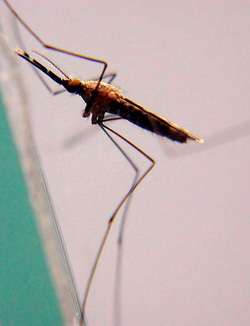Content
Anopheles quadrimaculatus
Malaria Mosquito
 |
|
Anopheles quadrimaculatus
|
Anopheles quadrimaculatus is known commonly as the Malaria Mosquito. It is the primary mosquito for transmitting malaria in Eastern North America. Since the formation of organized mosquito control in Florida, the number of locally acquired cases of malaria has diminished state wide. There have been a few reported outbreaks; the last was in 2003 in West Palm Beach. Eight residents were infected by mosquitoes from the area. Historically, most people infected have travelled to areas outside the United States where malaria is still common.
Description: Anopheles quadrimaculatus is a medium sized mosquito that is dark brown to black in color. A distinctive feature is a grouping of four spots on the wings, which is referenced in its scientific name. 'Quad' is four and 'maculatus' refers to the spots.
Home: These mosquitoes prefer to lay eggs in permanent pools of water with vegetation, such as ponds, and swamps. The mosquito develops from egg to adult in about two weeks.
Feeding: The Malaria Mosquito prefers to bite large mammals and humans after dusk.
Reduction/Elimination: It is difficult for the homeowner to control the breeding site of this mosquito. To prevent the adult from biting, check out our tips to avoid mosquitoes. Mosquito Control is constantly monitoring known breeding sites and inspecting for new ones.
Feeding: These mosquitoes prefer to feed at night on mammals.
Reduction/Elimination: This is a difficult mosquito for homeowners to control through water source reduction and elimination. Mosquito Control is constantly monitoring known swamps where the mosquitoes breed, treating when larvae are found to prevent the emergence of adults.
return to Common Mosquitoes